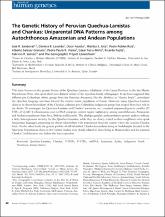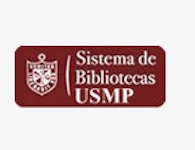The Genetic History of Peruvian Quechua-Lamistas and Chankas: Uniparental DNA Patterns among Autochthonous Amazonian and Andean populations

View/
Download
(application/pdf: 846.5Kb)
(application/pdf: 846.5Kb)
Date
2016-03Author(s)
Sandoval Sandoval, José Raul
Lacerda, Daniela R.
Acosta, Óscar
Jota, Marilza S.
Roblez, Paulo
Salazar Granara, Alberto Alcibíades
Paz-y-Miño, César
Fujita, Ricardo
Santos, Fabrício R.
Metadata
Show full item recordAbstract
The present study focuses on the genetic history of the Quechua-Lamistas, inhabitants of the Lamas Province
in the San Martin Department, Peru, who speak a peculiar dialect of the Quechua language related to the
Ecuadorian Quichua. It has been suggested that different pre-Columbian ethnic groups from the Peruvian
Amazonia, like the Motilones or “shaven heads”, assimilated the Quechua language and then formed the
current native population of Lamas. However, many Quechua-Lamistas claim to be direct descendants of the
Chankas, a famous pre-Columbian indigenous group that escaped from the Inca rule in the Andes. To
investigate the Quechua-Lamistas and Chankas’ ancestries, we compared uniparental genetic profiles (17
STRs of Y-chromosome Q-M3 and complete mtDNA control region haplotypes) among autochthonous
Amazonian and Andean populations from Peru, Bolivia and Ecuador. The phylogeographic and population
genetic analyses indicated that the Quechua-Lamistas ancestry were quite heterogeneous, but closely related
to their neighbors who speak Amazonian languages, presenting no direct relationships with populations from
the region where the ancient Chankas lived. On the other hand, the genetic profiles of self-identified Chanka
descendants living in Andahuaylas (located in the Apurimac Department, Peru, in the Central Andes) were
closely related to those living in Huancavelica and the assumed Chanka Confederation area before the Inca
expansion.
Collections
- Artículos [274]







